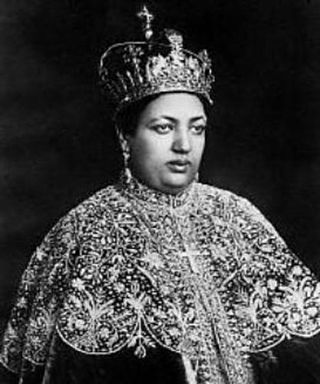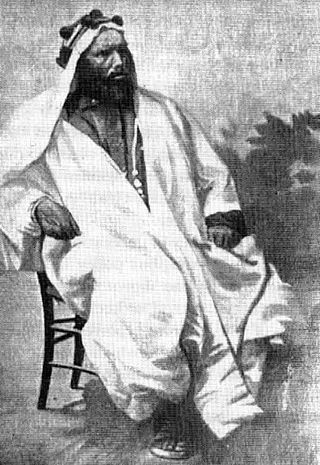Abba Seru Gwangul (died 1778) was a Son of Aba Getiye. Aba Getiye was a descendant of Sheikh Omar, most commonly referred to as a Wara Sheh, which means "Sons of the Sheikh".
The Wara Sheh began to have prominence with the emergence of Aba Gwangul who married Weyzero Gelebu, the daughter of Ras Faris of the Lasta district. Abba Seru Gwangul had numerous children including Dejazmach Welle, Dejazmach Kormi, Abeto Yimer, and Woizero Aster. With his wife Woizero Gelebu, daughter of Ras Faris of Lasta and Salawa, Abba Seru Gwangul had Ras Ali, Ras Aligaz and Woizero Kefey. [1]
Aba Gwangul's descendants came to control Begemder and parts of Wollo, and his heirs were Enderases (Regents) of the Ethiopian Empire and rulers of the Zemene Mesafint. [2]
The Scottish explorer James Bruce met him in 1770, and recorded a vivid description of this man in his account of travels in Ethiopia: [3]
He was a little, thin, cross-made man, of no apparent strength or swiftness, as far as could be conjectured; his legs and thighs being thin and small for his body, and his head large; he was of a yellow, unwholesome colour, not black nor brown; he had long hair plaited and interwoven with the bowels of oxen, and so knotted and twisted together as to render it impossible to distinguish the hair from the bowels, which hung down in long strings, part before his bread and part behind his shoulder, the most extraordinary ringlets I had ever seen. He had likewise, a wreath of guts hung about his neck, and several rounds of the fame about his middle, which served as a girdle, below which was a short cotton cloth dipt in butter, and all his body was wet, and running down with the same; he seemed to be about fifty years of age, with a confident and insolent superiority painted in his face. In his country it seems, when he appears in state, the beast he rides upon is a cow. He was then in full dress and ceremony, and mounted upon one, not of the largest sort, but which had monstrous horns. He had no saddle on his cow. He had short drawers, that did not reach the middle of his thighs; his knees, feet, legs, and all his body were bare. Whether it was necessary for the poizing himself upon the sharp ridge of the beast's back, or whether it was meant as graceful riding, I do not know, being quite unskilled in cowmanship; but he leaned exceedingly backwards, putting his belly forwards, and holding his left arm and shield stretched out on one side of him, and his right, arm and lance in the same way on the other, like wings. The king (Tekle Haymanot II)was seated on his ivory chair, to receive him, almost in the middle of his tent; the day was very hot, and an insufferable stench of carrion soon made every one in the tent sensible of the approach of this nasty sovereign, even before they saw him. The king, when he perceived him coming, was so struck with the whole figure and appearance, that he could not contain himself from an immoderate fit of laughter, which finding it impossible to stifle, he rose from his chair, and ran as hard as he could into another apartment behind the throne. The savage got off from his cow at the door of the tent with all his tripes about him; and, while we were admiring him as a monster, seeing the king's seat empty, he took it for his own, and down he sat upon the crimson silk cushion, with the butter running from every part of him. A general cry of astonishment was made by every person in the tent: he started up I believe without divining the cause, and before he had time to recollect himself, they fell all upon him, and with pushes and blows drove this greasy chieftain to the door of the tent, flaring with wild amazement, not knowing what was next to happen. It is high treason, and punishable by immediate death, to sit down upon the king's chair. Poor Guangoul owed his life to his ignorance. The king had beheld the whole scene through the curtain; if he laughed heartily at the beginning, he laughed ten times more at the catastrophe; he came out laughing, and unable to speak.

Menelik II, baptised as Sahle Maryam was King of Shewa from 1866 to 1889 and Emperor of Ethiopia from 1889 to his death in 1913. At the height of his internal power and external prestige, the process of territorial expansion and creation of the modern empire-state was completed by 1898.

RasMakonnen Wolde Mikael Wolde Melekot, or simply Ras Makonnen, also known as Abba Qagnew, was a Shewan royal from Menz, a military leader, the governor of Harar province in the Ethiopian Empire, and the father of Tafari Makonnen. His father was Dejazmach Wolde Mikael Wolde Melekot of Shewa. Makonnen was a grandson of Negus Sahle Selassie of Shewa through his mother, Woizero Tenagnework Sahle Selassie. As such, he was a first cousin of the Ethiopian Emperor, Menelik II.

Menen Asfaw was Empress of the Ethiopian Empire as the wife of Emperor Haile Selassie.

Tekle Giyorgis II was Emperor of Ethiopia from 1868 to 1871. After being crowned, he linked himself to the last independent emperors of the Gondar line through his mother and sought support from the Ethiopian Church to strengthen his right to rule. He was wounded when fighting during the 1871 Battle of Adwa, leading to the demoralization of his troops and capture of his generals which would later lead to the unification policy and effective rule of Yohannes IV.
Tekle Haymanot II, throne name: Admas Sagad III was Emperor of Ethiopia from 18 October 1769 to 13 April 1777, and a member of the Solomonic dynasty. He was the son of Yohannes II by Woizero Sancheviyar, at the Imperial prison of Mount Wehni.
Aligaz of Yejju was Ras of Begemder, and Inderase (regent) of the Emperor of Ethiopia. He was the son of Abba Seru Gwangul and brother of Ali I of Yejju; he became both Ras and Inderase following Ali's death. Aligaz had four sons: Dejazmach Birru, Dejazmach Gobeze, Dejazmach Faris, and Dejazmach Gojjee.
Ali I of Yejju was Ras of Begemder, and following the death of Ras Mikael Sehul, Regent of the Emperor of Ethiopia. He was the son of Abba Seru Gwangul, chieftain of the Yejju, and Woizero Gelebu Faris, daughter of Ras Faris of Lasta.

Mikael Sehul was a nobleman who ruled Ethiopia for a period of 25 years as regent of a series of weak emperors. He was also a Ras or governor of Tigray 1748–71 and again from 1772 until his death. He was a major political figure during the reign of Emperor Iyasu II and his successors until almost the time of his death.

Mentewab was Empress of Ethiopia, consort of Emperor Bakaffa, mother of Iyasu II and grandmother of Iyoas I. She was also known officially by her baptismal name of Walatta Giyorgis. Mentewab was a major political figure during the reigns of her son the Emperor Iyasu and grandson Iyoas. Empress Mentewab was also known by the honorific of Berhan Mogassa. This was to complement the honorific of her son Iyasu II, who was Berhan Seged.

Sabagadis Woldu was a governor of Tigray Province of the Ethiopian Empire from 1822 to 1831. Sabagadis gained some notoriety in the first decade of the 19th century for rebelling a number of times against his overlord, Ras Wolde Selassie. But just before the death of Wolde Selassie it seems that he made up with his master and became one of his loyal lieutenants. Following Wolde Selassie's death in 1816, he defied the authority of Wolde Selassie's son, and became the most powerful warlord in Tigray. Making Adigrat his capital, he ruled Tigray and a small strip of the coastal plains of Eritrea by 1818. His rule also extended to the Eritrean highlands.
The Battle of Debre Tabor was a conflict during the Zemene Mesafint in 1842 initiated by Dejazmach Wube Haile Maryam to overthrow Ras Ali II as Regent of the Emperor of Ethiopia and gain control of Ethiopia. This confused battle was won by Ras Ali, but at a steep price, and this victory failed to cement his position as the most powerful nobleman of his time.

Darge Sahle Selassie Horse name Abba Gersa was a 19th-century Ethiopian nobleman, provincial governor, general and a trusted councillor of his nephew Emperor Menelik II.

The Zemene Mesafint was a period in Ethiopian history between the mid-18th and mid-19th centuries when the country was ruled by a class of regional noblemen and the emperor was merely a figurehead. For the most part, the regional lords were tightly related by marriage and constituted a stable ruling elite that prevailed until the mid 20th century. In short, during the Zamana Masafint, the Emperors from the Solomonic dynasty were reduced to little more than figureheads confined to the capital city of Gondar.
Enderta or Inderta is a former historical province of Ethiopia; it is located in the eastern edge of the Tigray highlands. Enderta is bordered on the west by Tembien, on the south and southwest by Lasta and Wag, on the east by denkel, and on the north by Agame and Adwa. Mekelle was formerly the capital of the province. Enderta's local administration of Denkel/Afar up to the edges of Aseb under its jurisdiction seems to have been highly, interlinked with the operation of the salt trade and its taxation system; the entire tasks of salt caravan organization being the responsibility of the bäalgada, title assumed by the governor of Endärta, since at least the Medieval period.

Seyoum Mengesha KBE was an army commander and a member of the royal family of the Ethiopian Empire.

Ras Alula Engida was an Ethiopian general and politician who successfully led Abyssinian battles against Ottoman Egypt, the Mahdists and Italy. He was one of the most important leaders of the Abyssinian forces during the 19th century. Described by Haggai Erlich as the "greatest leader whom Ethiopia produced since the death of Emperor Tewodros II in 1868." Ras Alula was referred to by Europeans as "the Garibaldi of Ethiopia".
Muja is a town in northern Ethiopia. Part of the Semien Wollo Zone of the Amhara Region, this town has a latitude and longitude of 12°04′N39°27′E with an elevation of 2918 meters above sea level.
Dejazmach Birru Aligaz was a nobleman of 19th century Ethiopia during the Zemene Mesafint. As Dejazmach, he held the governorships of different districts such as Lasta and Dembiya and was made governor of Dawunt, Wollo in 1842 by Ras Ali II of Yejju. He was the son of Ras Aligaz Abba Seru Gwangul, and had a son called Dejazmach Zegeye.
Dejazmach Zegeye Birru was the son of Dejazmach Birru Aligaz. He was the ruler of Yejju until the emergence of Ras Welle Betul. Dejazmach Zegeye had four sons and a daughter: Wagshum Gwangul, Dejazmach Ali, Dejazmach Hailu, Dejazmach Aligaz, and Woizero Hirut.

Wube Haile Maryam of Semien, (1799-1867), also called by his title Dejazmach Wube, Webé; his name is also given in European sources as ‘‘Ubie’’. Wube was one of the major figures of 19th century Ethiopia, during the closing decades of the Zemene Mesafint a period of regional lords vying for power, prestige and territory amid a weakened authority of the emperors.